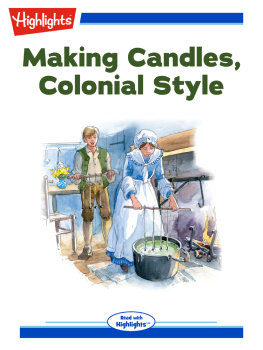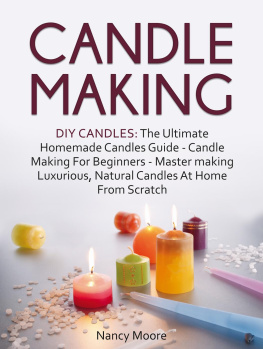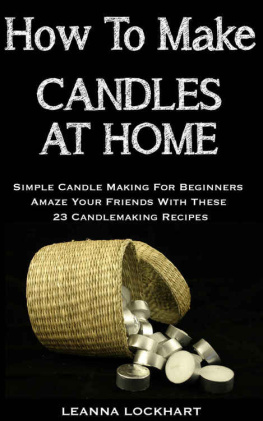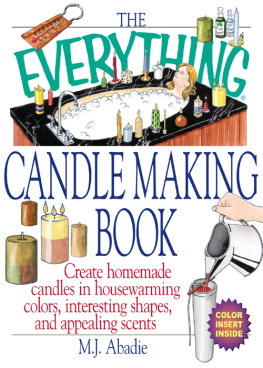Oppenheimer - Making Hand-Dipped Candles
Here you can read online Oppenheimer - Making Hand-Dipped Candles full text of the book (entire story) in english for free. Download pdf and epub, get meaning, cover and reviews about this ebook. year: 1999;2001, publisher: Storey Publishing, LLC, genre: Home and family. Description of the work, (preface) as well as reviews are available. Best literature library LitArk.com created for fans of good reading and offers a wide selection of genres:
Romance novel
Science fiction
Adventure
Detective
Science
History
Home and family
Prose
Art
Politics
Computer
Non-fiction
Religion
Business
Children
Humor
Choose a favorite category and find really read worthwhile books. Enjoy immersion in the world of imagination, feel the emotions of the characters or learn something new for yourself, make an fascinating discovery.

- Book:Making Hand-Dipped Candles
- Author:
- Publisher:Storey Publishing, LLC
- Genre:
- Year:1999;2001
- Rating:5 / 5
- Favourites:Add to favourites
- Your mark:
- 100
- 1
- 2
- 3
- 4
- 5
Making Hand-Dipped Candles: summary, description and annotation
We offer to read an annotation, description, summary or preface (depends on what the author of the book "Making Hand-Dipped Candles" wrote himself). If you haven't found the necessary information about the book — write in the comments, we will try to find it.
Making Hand-Dipped Candles — read online for free the complete book (whole text) full work
Below is the text of the book, divided by pages. System saving the place of the last page read, allows you to conveniently read the book "Making Hand-Dipped Candles" online for free, without having to search again every time where you left off. Put a bookmark, and you can go to the page where you finished reading at any time.
Font size:
Interval:
Bookmark:
Hand-Dipped Candles
excerpted from The Candlemakers
Companion by Betty Oppenheimer
Humans have used light to lengthen and brighten their days for 15,000 years. Hollowed-out stones filled with animal fat and used as lamps were among the earliest light sources. Modern-day oil lamps work in much the same way, with a wick pulling fuel up to a flame. Early methods of torch lighting involved soaking papyrus, flax, or other fibers in resins, pitch, or natural oils and burning them as torches. This technique progressed to the use of twisted fibers dipped in various combustible substances that remain solid at room temperature. These dipped fibers were early versions of candles.
A candle is a body of tallow, wax, or other fatty material formed around a wick and used for a portable light. In other words, a candle is a solid chunk of fuel wrapped around a wick. A candle works because the wick burns and melts the solid fuel into a liquid, which is transported by capillary action (wicked) to the flame, which vaporizes the fuel and burns it off.
Dipping is one of the oldest methods of candlemaking and one of the most hands-on. It is the process of building up layers of wax on a wick. The dipping process naturally creates tapers. I remember as a child watching in fascination as the women of Colonial Williamsburg dipped candles methodically and described the skill as one of the many tasks of a homemaker in early America. In addition to making the candles, women collected animal fats or berries and possibly raised bees to get the wax they needed. Today, most dipped candles are made of paraffin or beeswax or a blend of the two. Dipping harkens back to the early rush dips, long, fired grasses that were dipped into grease and used like torches.

It is hard to imagine the world of early candlelight, with its wide variety of materials, the hundreds of years with few or no technologicala breakthroughs, and the fact that the match (that little item we take for granted every day) was not invented until 1827!
Early candles were made of vegetable waxes produced from plants such as bayberries, candelilla leaves, candletree bark, esparto grass, and various varieties of palm leaves such as carnauba and ouricury. They were also made of animal tissue and secretions, such as spermaceti (whale oil), ambergris, and beeswax (insect secretions). Sometimes entire animals such as the stormy petrel and the candlefish of the Pacific Northwest were threaded with a wick and burned as candles. Tallow candles were made of sheep, cow, or pig fat. All these candles were rather crude, time-consuming to make, smoky, and smelly.
Of the two kinds of candle fuel, beeswax was considered the better product, as it burned cleaner than tallow and had a lovely odor compared to tallows rancid, smoky burn. Being scarce, beeswax was much more expensive. Only churches and the wealthy could afford beeswax candles. In fact, church rules insisted on beeswax candles because of the belief that bees were blessed by the Almighty. It was ordered that Mass be performed even during the day by the light of wax made by bees, as they represented spiritual joy.
Early chandlers dipped wicks into melted wax or poured wax over wicks repeatedly until a thick coating built up. In the 15th century wooden molds were developed, but they could not be used for beeswax because it was too sticky to release from wooden surfaces. The molded candlemaking method did make the process of forming tallow candles much easier, however, and tallow candles became more available and affordable. Still, candles burned quickly and their wicks had to be continuously trimmed (originally called snuffing) to prevent smoking.
By the 17th century, European state edicts controlled the weight, size, and cost of candles. In 1709, an act of the English Parliament banned the making of candles at home unless a license was purchased and a tax paid. Rushlights, made by dipping rushes or reeds in suet, were excluded from the tax and became the cheapest form of lighting. But, surprisingly, many peasants still bought the more expensive candles because their poverty meant little meat and little suet in their diet.
The 19th century finally brought with it a burst of new discoveries and inventions that revolutionized the candle industry and made lighting available to all. In the early- to mid-19th century, a process was developed to refine tallow with alkali and sulfuric acid. The result was a product called stearin. Stearin is harder and burns longer than unrefined tallows. This breakthrough meant tallow candles could be made without the usual smoke and rancid odor. Stearins were also derived from palm oils, so vegetable waxes as well as animal fats could be used to make candles.
Also in the 19th century, a method was developed for braiding wick fibers. This caused them to bend over and away from a candles flame, where they would burn to ash and eliminate the need for the constant snuffing, or trimming, of a candles wick. In addition, chemical treatments were developed for wick fibers that made them less flammable, so candles would burn longer and more efficiently.
Matches, which were invented in 1827 using poisonous phosphorus, improved by the end of the century, eliminating the need for sparking with flint, steel, and tinder, or for keeping a fire burning 24 hours a day.
But probably most important of all, paraffin was refined from oil around 1850, making petroleum-based candles possible. The combination of paraffin, which burns cleanly and without odor, and stearins, which harden soft paraffin, with new wick technologies developed in the 19th century, revolutionized the candle industry, giving us the tools and materials we still use for candle manufacturing.
While candlemaking materials improved, however, kerosene became popular as a less expensive and readily available replacement for whale oil lamp fuel. When this happened, oil lamps became the preferred source of artificial light. So even though candles improved in the 19th century, they never held as important a position as they did when they were the only available light source. In fact, 20th-century sales of candles are on a par with late-19th-century sales.
Nowadays, candles are used predominantly for romantic atmosphere, during electrical outages, and in spiritual quests and religious rituals. We share this with our 19th-century relatives we never stopped using candles, even after we no longer needed them!
To understand how to dip candles, you must first understand a few key concepts about how candles burn, and what supplies are required to make them burn well. A candle flame burns because of the two main ingredients: fuel and wick. When you light a candle, the wick catches fire and that fire heats to melting a small pool of wax just below the flame. The wick draws up that liquid wax to feed the flame, and the wick burns away at the top. In a good candle, the fuel (wax) burns more quickly than the wick does.
When youre burning your candles, watch the wick and flame in order to determine whether you have achieved good combustion. A candle that is burning well will have a 1- to 2-inch, steadily burning flame. The wick should bend over at approximately 90 degrees or stick straight up into the oxidation zone at the top of the flame so that the tip is almost to the edge of the flame and can burn to ash. The wax should form a liquid pool surrounding the wick not so big as to spill over but not so dry that the wick has no liquid to pull up.
Font size:
Interval:
Bookmark:
Similar books «Making Hand-Dipped Candles»
Look at similar books to Making Hand-Dipped Candles. We have selected literature similar in name and meaning in the hope of providing readers with more options to find new, interesting, not yet read works.
Discussion, reviews of the book Making Hand-Dipped Candles and just readers' own opinions. Leave your comments, write what you think about the work, its meaning or the main characters. Specify what exactly you liked and what you didn't like, and why you think so.








